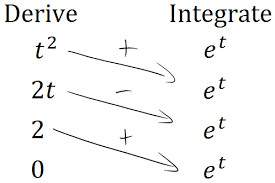Tubular Integration by Parts

Tabular Method
Suppose  and
and  . Then if we set up a table, differentiating f(x) as many times as it takes to get to zero and integrating g(x) as many times, we get
. Then if we set up a table, differentiating f(x) as many times as it takes to get to zero and integrating g(x) as many times, we get
Notice how we alternate the signs in the “I” column. Then, multiplying rows with like letters (which you can skip on your own paper to help make this clearer - draw arrows instead from (a) to (a), etc.) gives the following directly as the anti-derivative:
 This method is much faster than the f-g method or the older u-v, especially for iterated (more than once) integrals by parts
This method is much faster than the f-g method or the older u-v, especially for iterated (more than once) integrals by parts
| D | I |
| + | |
| - | |
| + |